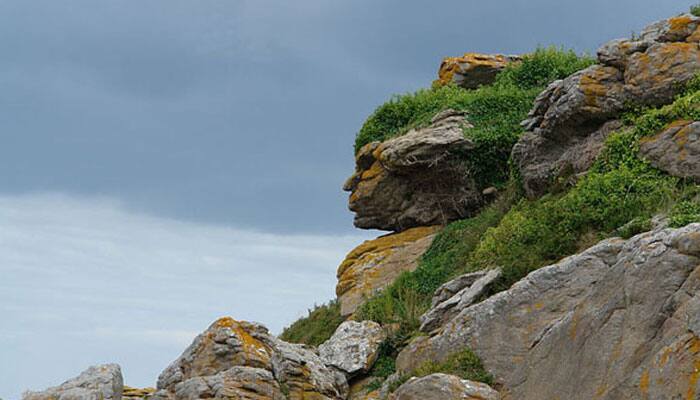Ritu Singh
Look at the above picture, what do you see? Do you see a green haired man? For some people, it's just a rocky hill. But for the majority of us, the assemblage of these meaningless angles takes on a familiar appearance i.e of a human face.
Often when you see clouds drifting in the sky, does your mind conjure a bunny or a human face out of it? Also do you find random patterns on your meal staring back at you? If you have said yes to all the above questions, don't worry, there is nothing wrong with you! There's a name for this phenomenon and many people experience it, it's called pareidolia.

For instance, take the example of this bread! If you see an angry face in this bread, you can be sure you experience this phenomenon.
While pareidolia was at one time thought to be related to psychosis, it's now generally recognized as a perfectly healthy tendency. We wonder why does our brain construct these illusions? Carl Sagan theorized that hyper facial perception stems from an evolutionary need to recognize, often quickly -faces. Somehow, our mind tries to make sense of the disconnected patterns and shapes around us and most often these incoherent dimensions take the shape of a human face.
What exactly is Pareidolia?
Pareidolia is the psychological response to seeing faces and other significant and everyday items in random stimulus. It is a form of apophenia, which is when people see patterns or connections in random, unconnected data.
Most humans do have a tendency to see faces where there are none and to read significance into random or vague stimuli (both visual and auditory).
It’s common for people to see non-existent features because human brains are uniquely wired to recognise faces, so that even when there’s only a slight suggestion of facial features, the brain automatically interprets it as a face.

Now look at this picture. In 1976 NASA sent two spacecraft called Viking 1 and Viking 2 to Mars. Both spacecraft took images of the planet's surface and beamed them back to NASA scientists on Earth. One image, taken on 25 July 1976 by Viking 1, showed what appeared to be a face in the rocks.
Why does it happen?
Though it's a very common phenomenon , but little is known about why it happens. When researchers analysed brain responses to seeing faces in patterns, they found out that the response first originates in the brain's frontal cortex and travels to the visual cortex. Findings suggest humans have evolved to recognise facial shapes due to their importance in social interactions.
Scientists also conclude that is basely human about the tendency to see faces in the non-human shapes around us.
We use an area of the brain known as the right fusiform face area to process faces. This area also becomes engaged when we perceive faces in other objects, according to a neuroscientist.
The researchers also said that the same phenomenon also happens in auditory and tactile domains as well. For example: You mishear voices in a noisy environment or feel your cell phone vibrating when it's not.
Check out one more:

This shocked faucet seems as confused as you! Admit it or not, the way our minds work and the way we keep seeing these faces in random objects is both funny and awesome!
Picture Credit: Imgur,NASA
















